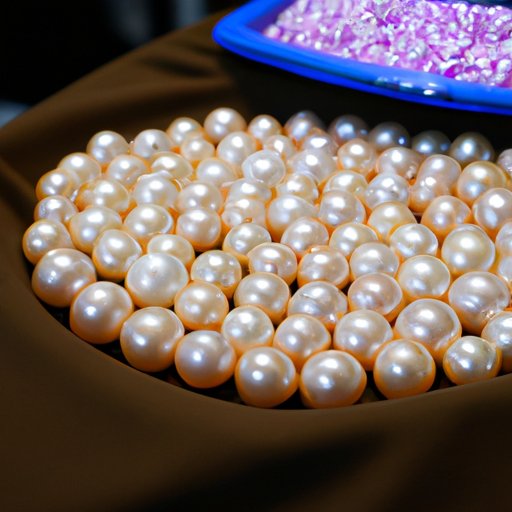Introduction
Cultured freshwater pearls are a type of pearl created in mollusks that live in freshwater rivers and lakes. They are formed when a tiny particle or bead is introduced into the mollusk, which then secretes nacre around the irritant to create a pearl. Cultured freshwater pearls come in a variety of shapes, sizes, and colors, making them a popular choice for jewelry makers and those looking to add some sparkle to their wardrobe.

Definition of Cultured Freshwater Pearls
Cultured freshwater pearls are pearls that have been grown in mollusks under controlled conditions. Unlike natural pearls, which form spontaneously, cultured freshwater pearls are created through human intervention. The process begins with a skilled technician inserting a tiny bead or nucleus into the mollusk, and the mollusk then secretes layers of nacre around the nucleus until it forms a pearl.
Overview of the Benefits of Wearing Cultured Freshwater Pearls
Cultured freshwater pearls are often seen as a symbol of beauty and elegance, and wearing them can bring a number of benefits. Not only can they add a touch of sophistication to any outfit, but they can also provide health benefits and help to promote positive energy. In addition, they are relatively affordable compared to other types of pearls, making them accessible to a wider range of people.
History of Cultured Freshwater Pearls
The practice of culturing freshwater pearls dates back centuries, with evidence of pearls being harvested from freshwater mussels in China as early as the 13th century. The technique was perfected over the years and spread to other parts of Asia, including Japan and India. By the 20th century, freshwater pearl farming had become a major industry in many countries, with millions of pearls being produced each year.

Characteristics of Cultured Freshwater Pearls
Cultured freshwater pearls come in a variety of shapes, sizes, and colors. The most common shapes are round, semi-round, baroque, and drop, and the size of the pearl typically ranges from 2mm to 10mm. As for color, cultured freshwater pearls can be found in shades of white, pink, lavender, peach, and black.
Benefits of Wearing Cultured Freshwater Pearls
In addition to their aesthetic appeal, there are several benefits to wearing cultured freshwater pearls. These include:
Health Benefits
Wearing cultured freshwater pearls can help to improve physical and mental well-being. They are believed to possess healing properties that can reduce stress and anxiety, improve immunity, and boost energy levels. In addition, they can help to promote healthy skin and hair.
Beauty Benefits
Cultured freshwater pearls are a great way to add a touch of sophistication to any ensemble. They can be worn with formal or casual attire, and they can be mixed and matched with other pieces of jewelry to create unique looks. In addition, they can help to draw attention to the wearer’s face, making them appear more youthful and vibrant.

How to Care for Cultured Freshwater Pearls
Caring for cultured freshwater pearls is essential if you want to keep them looking their best. The following tips can help:
Cleaning
Cultured freshwater pearls should be cleaned regularly using a soft cloth and lukewarm water. Avoid using detergents or harsh chemicals, as these can damage the delicate surface of the pearls. For tougher stains, use a mild soap and gently rub the pearls with your fingers.
Storage
When not being worn, cultured freshwater pearls should be stored in a cool, dry place away from direct sunlight. If possible, store them in a jewelry box or pouch lined with a soft cloth. This will help to protect them from dust and dirt and keep them looking their best.
Popular Cultured Freshwater Pearl Jewelry
Cultured freshwater pearls are a popular choice for jewelry makers, and they can be used to create a range of stunning pieces. Necklaces, earrings, and bracelets are all popular options, and the pearls can be combined with other materials such as gold, silver, and gemstones to create one-of-a-kind designs.

Shopping Tips for Cultured Freshwater Pearls
When shopping for cultured freshwater pearls, it’s important to keep a few things in mind. Here are some tips to help you make the right decision:
Quality Assurance
When buying cultured freshwater pearls, it’s important to ensure that you are getting a quality product. Check for signs of wear and tear, and make sure that the pearls are properly graded according to size, shape, and color. It’s also a good idea to ask for a certificate of authenticity from the seller.
Price Comparison
It’s always a good idea to compare prices before making a purchase. Look online and in stores to get an idea of what different retailers are offering, and don’t be afraid to negotiate for the best deal. Remember, the more you shop around, the better deals you’ll be able to find.
Conclusion
Cultured freshwater pearls are a beautiful and elegant addition to any wardrobe. They come in a variety of shapes, sizes, and colors, making them a perfect choice for jewelry makers and those looking to add some sparkle to their look. In addition, they offer a range of health and beauty benefits, and can be cared for easily with regular cleaning and storage. With the right knowledge and a bit of research, you can find the perfect cultured freshwater pearl jewelry to suit your style.
(Note: Is this article not meeting your expectations? Do you have knowledge or insights to share? Unlock new opportunities and expand your reach by joining our authors team. Click Registration to join us and share your expertise with our readers.)
